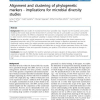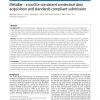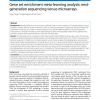BMCBI
2010
13 years 11 months ago
2010
Background: Understanding the genetic basis of disease risk in depth requires an exhaustive knowledge of the types of genetic variation. Very recently, Copy Number Variants (CNVs)...
BMCBI
2010
13 years 11 months ago
2010
Background: Molecular studies of microbial diversity have provided many insights into the bacterial communities inhabiting the human body and the environment. A common first step ...
BMCBI
2010
13 years 11 months ago
2010
Background: Determining a suitable sample size is an important step in the planning of microarray experiments. Increasing the number of arrays gives more statistical power, but ad...
BMCBI
2010
13 years 11 months ago
2010
Background: An algorithm is presented to compute a multiple structure alignment for a set of proteins and to generate a consensus (pseudo) protein which captures common substructu...
BMCBI
2010
13 years 11 months ago
2010
Background: Subtle alternative splicing events involving tandem splice sites separated by a short (2-12 nucleotides) distance are frequent and evolutionarily widespread in eukaryo...
BMCBI
2010
13 years 11 months ago
2010
Background: Protein kinases play crucial roles in cell growth, differentiation, and apoptosis. Abnormal function of protein kinases can lead to many serious diseases, such as canc...
BMCBI
2010
13 years 11 months ago
2010
Background: Environmental sequence datasets are increasing at an exponential rate; however, the vast majority of them lack appropriate descriptors like sampling location, time and...
BMCBI
2010
13 years 11 months ago
2010
Background: Reproducibility of results can have a significant impact on the acceptance of new technologies in gene
BMCBI
2010
13 years 11 months ago
2010
Background: The enumeration of tetrameric and other sequence motifs that are positively or negatively correlated with in vivo antisense DNA effects has been a useful addition to t...
BMCBI
2010
13 years 11 months ago
2010
Background: A protein binding hot spot is a small cluster of residues tightly packed at the center of the interface between two interacting proteins. Though a hot spot constitutes...



